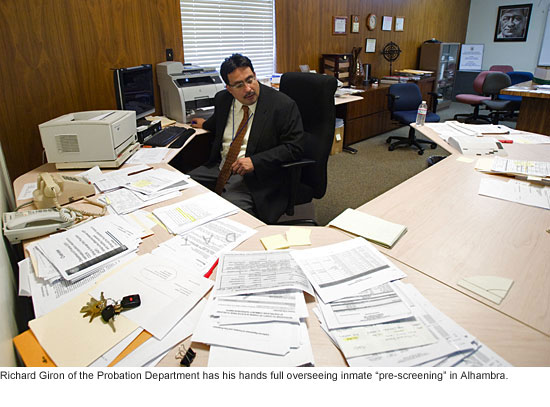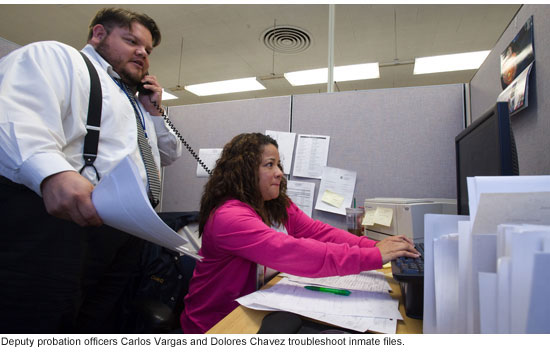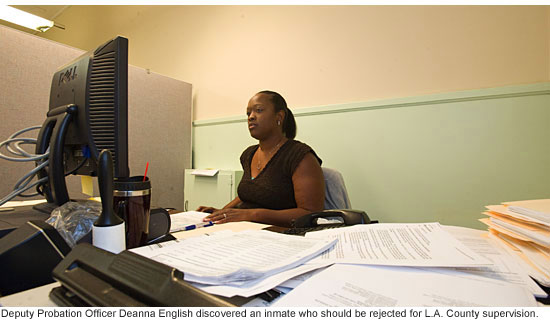Realignment gets all too real
October 6, 2011
 Inside a cramped, dingy-white building in Alhambra, one of California’s most radical—and some say reckless—experiments in its criminal justice history is unfolding. There, officials are getting a detailed first look at some of the thousands of state inmates who’ll be supervised by Los Angeles County once they’re freed, a process that began this week.
Inside a cramped, dingy-white building in Alhambra, one of California’s most radical—and some say reckless—experiments in its criminal justice history is unfolding. There, officials are getting a detailed first look at some of the thousands of state inmates who’ll be supervised by Los Angeles County once they’re freed, a process that began this week.
So far, it’s not an encouraging sight.
Hundreds upon hundreds of prisoner files—some woefully incomplete—are haphazardly arriving by mail, fax and Fed-Ex at Los Angeles County’s “pre-screening” hub in the Probation Department’s Alhambra field office. Eagle-eyed probation workers are uncovering mistakes, large and small, in the state records, including inmates who should be sent to other counties and others whose crimes should disqualify them entirely from the new “realignment” program.
Only late last week, after intense pressure from L.A. County, did state corrections authorities even begin sending comprehensive mental health records on ex-convicts headed here for supervision, information that’s crucial in developing treatment plans for the clients and protection for the public.
What’s also become increasingly clear in recent days is that the state has not been entirely forthcoming about the fine print of the controversial realignment plan, which is aimed at reducing prison overcrowding while slashing the state’s budget deficit.
Again and again, the governor and legislature have publicly stressed that the ex-inmates who’ll be supervised by the counties are “low-level” offenders convicted of non-serious, non-violent, non-sexual crimes. They also note that these individuals would have returned to their home counties no matter who was responsible for their oversight. But that’s not the whole story, as L.A. County officials are quickly learning.
These same felons could—and sometimes do—have prior cases involving very serious crimes. Under the realignment law, AB 109, only the most recent conviction, or “commitment offense,” is considered in determining whether inmates will be supervised by counties or state parole agents after their release.
Take, for example, one inmate who was scheduled to be freed on Wednesday and has been ordered to report to L.A.County for post-release supervision. He was serving time for second-degree commercial burglary, attempted grand theft of personal property, forgery and identity theft—all non-serious, non-violent crimes under the penal code. But over the previous decade, he had more than a dozen arrests or convictions for a slew of serious and violent crimes, including assault with a deadly weapon, robbery and terrorist threats.
“We’re literally seeing every criminal record you could think of,” says Richard Giron of the Probation Department, who’s in charge of the pre-screening center in Alhambra, where nearly 2,000 files have been received. “We’re seeing prior violence, prior sex offenses—the full range of minimal criminal records to extensive, serious records.”
Giron says his staff is flagging such individuals for heightened supervision as part of the case plans developed when inmates arrive at other hubs throughout the region for face-to-face interviews.
Reaver Bingham, the Probation Department’s deputy chief of adult services and juvenile placement, called some of the county’s new charges “very hard core” but insisted that his agency is trained and prepared to deal with them. “This population is not unfamiliar to us,” he said, noting that the department currently supervises 15,000 adults with histories of serious and violent crimes.
In recent weeks, as AB 109’s October 1 implementation date drew near, concerns about public safety took center stage, with the harshest warnings coming from Los Angeles County District Attorney Steve Cooley. He predicted that crime rates would soar not only because of the freed inmates who’ll be under county supervision but because, under the law, defendants convicted of non-violent, non-serious crimes will now be sentenced to county jail rather than state prison. He and others argue that this will lead to even greater jail overcrowding and more inmates being released early by the Sheriff’s Department, which manages the sprawling system.
In the Alhambra screening center, Giron and his hand-picked team understand the high stakes for public safety and are determined to make sure no inmate is erroneously placed under the county’s jurisdiction. His 11 deputy probation officers and two supervisors scour every document the state sends and then comb criminal databases, as well as court records, for additional information on each of the inmates scheduled for release.
In the process, Giron says, his staff has uncovered mistakes that have given county officials ammunition to keep dozens of inmates from falling under probation’s purview.
“I’m doing everything I can in my power to reject cases that are inappropriate for supervision in L.A. County,” Giron says. Those cases have included an inmate who’d been serving time for molesting a child under the age of 14, a prisoner convicted of a serious extortion attempt and yet another who was described by the state’s own prison board as not safe to be released.
On Wednesday morning, Deputy Probation Officer Deanna English, a 22-year veteran of the department, found yet another, using the scant information contained in the state’s own file as a springboard.
Corrections officials had determined that a 20-year-old inmate at the California Rehabilitation Center in Norco was eligible for county supervision because, according to a release form, he was serving time for a second degree burglary. But that was wrong. Contained within the file itself was the notation that he’d been sentenced for a robbery, a serious crime that would exempt him from the realignment program. English says she then checked the actual court record, which confirmed the robbery conviction.
“Honestly speaking, I thought they were trying to pull one over on us,” she says of corrections officials. “Their thing is to get as many [inmates] out of the state system as they can.” English says she feels “a high sense of duty” to thoroughly vet every file.
Making the job even more challenging for the Alhambra crew is the fact that the state has no centralized point of contact. The county is receiving files from 33 separate prisons. And those files are not being sent based on the chronological release dates of inmates, dates that seem to be constantly shifting.
Just the other day, as Giron talked with a visitor from Supervisor Zev Yaroslavsky’s office, another probation supervisor, Al Montellano, walked up with a handful of documents fresh off the fax. They stated that eight inmates scheduled for release on December 4 will now be freed on October 23, meaning that the time-consuming review of their cases will have to be rushed into the mix, putting others on hold.
“That,” Giron says with a hint of understatement, “is operationally inefficient.”
Progress finally has been achieved, however, in one of the most crucial facets of the screening process—determining the mental health status and needs for the estimated 20 percent of inmates coming to the county who’ll need some level of treatment.
For months, the Los Angeles County Department of Mental Health, a key player in the realignment process, had been stymied in its efforts to obtain comprehensive treatment records for inmates. The information provided by the state was simply a notation that mental health services had been delivered in prison.
“We were getting promises and assertions that were not true,” says Dr. Marvin Southard, director of mental health. “It was very frustrating.”
Among other things, Southard says his department was directed to dial an information number on the inmate forms. “If you call that number, you get a correctional counselor—the cell-block staff person—but they have no access to the medical records,” Southard says.
Further, according to Southard, his staff was told that they’d have to individually contact each of the state’s 33 prisons for information, which would consume crucial time in learning an inmate’s needs and creating a treatment plan.
The issue reached a boiling point two weeks ago when the Board of Supervisors voted to send a stern letter to Gov. Jerry Brown. In it, they warned that, unless the necessary information was forthcoming, “we will not accept parolees with mental health issues.”
“After that, everything changed,” Southard says, noting that a centralized system was developed by California’s corrections officials. “The governor’s staff promised that we’d get the records we need.”
Still, even if the county manages to overcome all these logistical challenges, there’s still the overarching question of whether the state will provide the money necessary to make it all work today and in the future.
“This has been my concern from Day One,” says Supervisor Yaroslavsky. “We’ve been asked to take a leap of faith that the reimbursement is adequate to meet our responsibilities. You can’t blame us for being skeptical, especially given the problems that have emerged in the opening days of this program. Even though the governor has assured us he will make us whole, it’s not entirely up to him and that makes me nervous.”
Posted 10/6/11













 405 bridge work causes a stink
405 bridge work causes a stink
